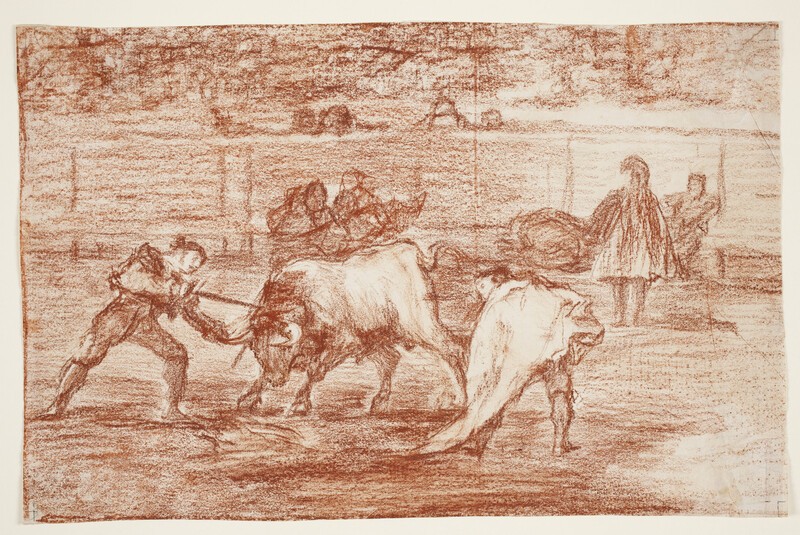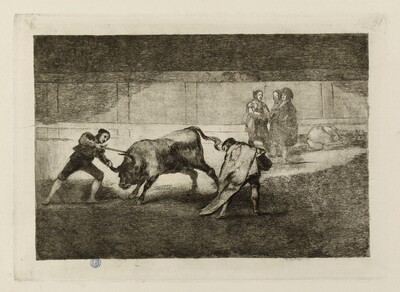- Cronología
- Ca. 1814 - 1816
- Ubicación
- The Prado National Museum. Madrid, Madrid, Spain
- Dimensiones
- 187 x 289 mm
- Técnica y soporte
- Reconocimiento de la autoría de Goya
- Documented work
- Titular
- El Prado National Museum
- Ficha: realización/revisión
- 03 Oct 2021 / 22 Jun 2023
- Inventario
- (D4306)
9 (in pencil, lower left corner)
1 (reverse, centre)
228 (reverse, lower left)
37 (reverse, top centre)
42 (reverse, top)
Unpublished (reverse, upper middle)
See How the ancient Spaniards hunted bulls on horseback in the countryside.
This preparatory drawing passed by inheritance in 1828 to Javier Goya, the painter's son, and in 1854 to Mariano Goya y Goicoechea, the artist's grandson. It was subsequently owned by Valentín Carderera (ca. 1861) and Mariano Carderera (1880). In 1886 it was acquired from Mariano Carderera, along with many other drawings by Goya, including almost all the preparatory studies for the Bullfight, by the Directorate General of Public Instruction, and was assigned to the Prado Museum, where it entered on 12 November 1886.
See How the ancient Spaniards hunted bulls on horseback in the countryside.
Preparatory drawing for the print A bullfighter plunges the rapier by grabbing the bull by a horn (Bullfighting L). This preparatory study is very similar to the later engraving, as it will be transferred to the plate with remarkable fidelity. Goya retained the composition present here, although slight changes were made, such as the removal of a secondary group of figures.
The scene shows the moment in which the bullfighter is thrusting his rapier at the bull while grabbing a piton with his other hand. The bull's gesture is the same as in the later engraving: he seems to be leaping forward, facing the bullfighter. Already in the foreground is the subalterno with a cape who seems to be moving away from the main action. In the background we see a figure with a hat and cape, with his back turned, with another figure and a dead horse to one side. Another secondary group is to the left of the previous one. It will be suppressed in the print to lighten the composition and make it easier to read. In the background are the barrier with some of the figures behind it, and the bullring with the audience, although it is very sketchy, so it does not give the impression of a mass.
The light in the preparatory study is still different from that in the later engraving, which is more intense and extensive than in the present one.
The present drawing is affixed to a second laid paper belonging to a French army record book in Spain.
The paper still has creases from the press.
-
Goya. Gemälde Zeichnungen. Graphik. TapisserienKunsthalle BaselBasle1953from January 23th to April 12th 1953cat. 102
-
cat. 50
-
cat. 50
-
cat. 50
-
cat. 50
-
cat. 50
-
Goya: toros y torerosEspace Van GoghArles1990displayed also at Academia de Bellas Artes de San Fernando, Madrid, consultant editor Pierre Gassier.cat. 43-44
-
Madrid1990
-
MadridMuseo del Prado1954cat. 192
-
OxfordBruno Cassirer1964vol. II, 1964, p. 362, cat. 247a
-
Vie et ouvre de Francisco de GoyaParísOffice du livre1970p. 281, cat. 1242
-
Dibujos de Goya, 2 volsBarcelonaNoguer1975pp. 426-427, cat. 288
-
El mundo de Goya en sus dibujosMadridUrbión1979pp.211-212
-
MilwakeeMilwaukee Art Museum1986p. 20
-
MadridMuseo Nacional del Prado2001pp. 110-111

